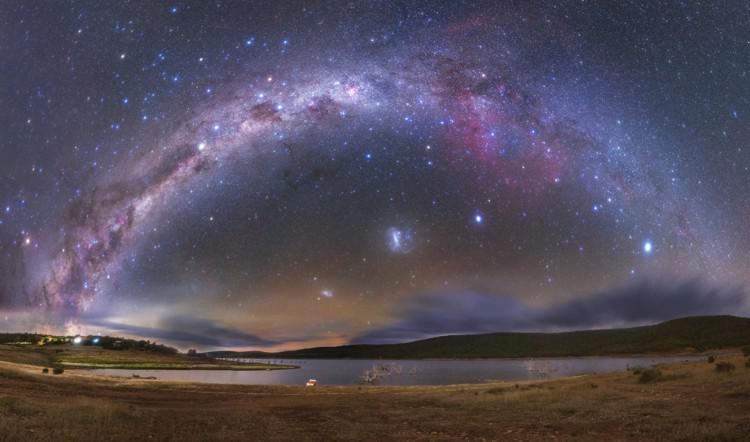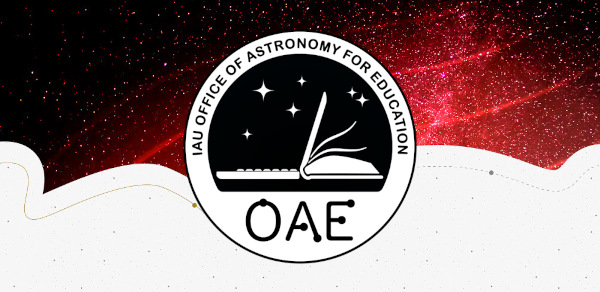This page describes an image The Milky Way Over Anglers Reach
Image caption:
Winner in the 2022 IAU OAE Astrophotography Contest, category Still images of celestial patterns.
The Milky Way and several astronomical objects are seen in this image taken from the southern hemisphere, in Anglers Reach, Australia, in April 2022.
On the bottom-left side we can identify the constellation Scorpius with its brightest star, Antares, the reddish spot just above the arc. Some prominent but small southern constellations can also be seen: the dominating bright stars in the middle-left of the image in the Milky Way are the four bright stars of Crux (the Southern Cross) and to its left the two pointer stars, alpha and beta Centauri. Crux points towards the southern celestial pole, which is not marked by a bright star, and The pointer stars point towards Crux, distinguishing it from the asterism of the False Cross in the constellation Argo.
Crux features on the national flags of Australia, Brazil, Papua New Guinea, Samoa and New Zealand. As Crux lies in the brightest parts of the Milky Way, the dark cloud of the famous Coalsack Nebula is prominent next to the bright stars. It forms one of the dark constellations in South American, South African and Australian indigenous cultures. The huge Australian dark constellation of the Emu is almost completely above the horizon in this image, stretching from its head in the Coal Sack to the horizon.
In Greek antiquity, the stars of Crux also belonged to the constellation Centaurus, a hybrid creature with a human torso and head attached to a horse body with four legs. The Greek centaur represents Chiron, the wise teacher of all Greek heroes. Its brightest star is Rigil Kentaurus (Alpha Centauri), the front hoof of the centaur. Just below it, we find the small constellation Triangulum Australe. The triple star system of Alpha Centauri is our Sun’s nearest stellar neighbour.
Along the Milky Way in the middle-right of the picture we find the huge constellation Argo, the Ship. The smaller ancient constellation Argo was extended by Dutch navigators around 1600, and the number of stars in this constellation was then so big that the 18th-century French mathematician Lacaille needed to introduce subtitles for Argo in his star catalogue. In doing so, he invented the constellations Puppis, Carina and Vela. In Carina, the Keel of the ship, this reddish photograph clearly displays the Carina Nebula.
At the right edge of the image we can spot the brightest star in the night sky, Sirius, while the second brightest star, Canopus, the rudder of Argo, the Ship, dominates the area under the arch of the Milky Way.
Also below the Milky Way arc, we can see the Large Magellanic Cloud and the Small Magellanic Cloud, which are small satellite galaxies of our own Galaxy.
Scroll to captions in other languages
Image credit:
Lucy Yunxi Hu/IAU OAE
DOI: 10.5281/zenodo.7425274
Related glossary terms:
Alpha Centauri
, Color
, Dust
, Dust Cloud
, Interstellar Extinction
, Large Magellanic Cloud (LMC)
, Milky Way
, Scorpius
, Small Magellanic Cloud (SMC)
, Southern Cross
Categories:
Galaxies
, Milky Way and Interstellar Medium
, Naked Eye Astronomy
Image license: Creative Commons Attribution 4.0 International (CC BY 4.0) Creative Commons Attribution 4.0 International (CC BY 4.0) icons
The media file captions presented on the OAE website were written, translated and reviewed by a collective effort from the OAE, the OAE Centers and Nodes, the OAE National Astronomy Education Coordinators (NAECs) and other volunteers. You can find a full list of credits for our translation project here. All media file captions are released under a Creative Commons CC BY-4.0 license and should be credited to "IAU OAE". The media files themselves may have different licenses (see above) and should be credited as listed above under "credit".
Captions in Different Languages:
Image caption: Auszeichnung beim IAU OAE Astrofoto-Wettbewerb 2022, Kategorie Weitwinkelaufnahmen von Himmelsmustern
Die Milchstraße und mehrere astronomische Objekte sind auf diesem Bild zu sehen, das im April 2022 von der Südhalbkugel der Erde aus in Anglers Reach in Australien aufgenommen wurde.
Links unten sehen wir das Sternbild Skorpion mit seinem hellsten Stern Antares, der rötliche Fleck direkt über dem Milchstraßenbogen. Einige markante, aber kleine südliche Sternbilder sind ebenfalls sichtbar: Die dominierenden hellen Sterne mittig links in der Milchstraße sind die vier hellen Sterne des Kreuz des Südens (lat. Crux) und links davon die beiden Zeigersterne alpha und beta Centauri. Das Kreuz des Südens zeigt in Richtung des südlichen Himmelspols, der nicht durch einen hellen Stern gekennzeichnet ist, während die Zeigersterne zum Kreuz zeigen. Dadurch kann man es vom Asterismus des Falschen Kreuzes im Sternbild Argo unterscheiden.
Das Kreuz des Südens ist auf den Nationalflaggen von Australien, Brasilien, Neuseeland, Papua-Neuguinea und Samoa dargestellt. Da es in den hellsten Teilen der Milchstraße liegt, ist die dunkle Wolke des bekannten Kohlensacknebels neben den hellen Sternen deutlich zu sehen. In den Kulturen der Ureinwohner Südamerikas, Südafrikas und Australiens bildet er eines der aus Dunkelwolken bestehenden Sternbilder. Das riesige australische Dunkelwolken-Sternbild des Emu befindet sich auf diesem Bild fast vollständig über dem Horizont und erstreckt sich von seinem Kopf im Kohlensack bis zum Horizont.
In der griechischen Antike gehörten die Sterne des Kreuz des Südens mit zum Sternbild Centaurus, einem Mischwesen mit menschlichem Oberkörper und Kopf, die mit einem einem Pferdekörper mit vier Beinen verbunden waren. Der griechische Zentaur stellt Chiron dar, den weisen Lehrer aller griechischen Helden. Sein hellster Stern ist Rigil Kentaurus (alpha Centauri), der Vorderhuf des Zentauren. Direkt darunter befindet sich das kleine Sternbild Triangulum Australe. Das Dreifachsternsystem von alpha Centauri ist der nächste stellare Nachbar unserer Sonne.
Entlang der Milchstraße mittig rechts finden wir das große Sternbild des Schiffs Argo. Das kleinere antike Sternbild Argo wurde um 1600 von holländischen Seefahrern erweitert, und die Anzahl der Sterne in diesem Sternbild war dann so groß, dass der französische Mathematiker Lacaille im 18. Jahrhundert in seinem Sternkatalog Untertitel für Argo einführen musste. Dabei erfand er die Sternbilder Puppis, Carina und Vela. In Carina, dem Schiffskiel, zeigt diese rötliche Aufnahme deutlich den Carina-Nebel.
Am rechten Bildrand befindet sich Sirius, der hellste Stern des Nachthimmels, während Canopus, der zweithellste Stern, als das Ruder des Schiffs Argo den Bereich unter dem Bogen der Milchstraße dominiert.
Ebenfalls unterhalb des Milchstraßenbogens befinden sich die Große und die Kleine Magellansche Wolke, die kleine Begleitgalaxien unserer Milchstraße sind.
Image credit: Lucy Yunxi Hu/IAU OAU
Related glossary terms: Alpha Centauri , Dust Cloud , Farbe , Interstellare Extinktion , Kleine Magellansche Wolke (KMW) , Kreuz des Südens , Large Magellanic Cloud (LMC) , Milchstraße , Skorpion , Staub Caption translation status: Not yet approved by a reviewer
Caption translators: Carolin Liefke
Image caption: Gagnant du concours d'astrophotographie 2022 de l'AIU OAE, catégorie Images fixes de motifs célestes.
La Voie lactée et plusieurs objets astronomiques sont visibles sur cette image prise depuis l'hémisphère sud, à Anglers Reach, en Australie, en avril 2022.
En bas à gauche, on peut identifier la constellation du Scorpion avec son étoile la plus brillante, Antarès, la tache rougeâtre juste au-dessus de l'arc. Quelques constellations australes importantes mais de petite taille sont également visibles : les étoiles brillantes dominantes au milieu gauche de l'image dans la Voie lactée sont les quatre étoiles brillantes de Crux (la Croix du Sud) et, à sa gauche, les deux étoiles-pointeurs, alpha et bêta Centauri. Crux pointe vers le pôle céleste sud, qui n'est pas marqué par une étoile brillante, et les étoiles indicatrices pointent vers Crux, ce qui la distingue de l'astérisme de la Fausse Croix dans la constellation d'Argo.
Crux figure sur les drapeaux nationaux de l'Australie, du Brésil, de la Papouasie-Nouvelle-Guinée, de Samoa et de la Nouvelle-Zélande. Comme Crux se trouve dans les parties les plus lumineuses de la Voie lactée, le nuage sombre de la célèbre nébuleuse du Coalsack est proéminent à côté des étoiles brillantes. Elle constitue l'une des constellations sombres dans les cultures indigènes d'Amérique du Sud, d'Afrique du Sud et d'Australie. L'énorme constellation sombre australienne de l'émeu est presque entièrement au-dessus de l'horizon sur cette image, étirant sa tête depuis le Sac à Charbon jusqu'à l'horizon.
Dans l'Antiquité grecque, les étoiles de Crux appartenaient également à la constellation du Centaure, une créature hybride avec un torse et une tête humains attachés à un corps de cheval à quatre pattes. Le centaure grec représente Chiron, le sage professeur de tous les héros grecs. Son étoile la plus brillante est Rigil Kentaurus (Alpha Centauri), le sabot avant du centaure. Juste en dessous, on trouve la petite constellation Triangulum Australe. Le système stellaire triple d'Alpha du Centaure est le plus proche voisin stellaire de notre Soleil.
Le long de la Voie lactée, au milieu à droite de l'image, se trouve l'immense constellation Argo, le navire. L'ancienne constellation Argo, plus petite, a été élargie par les navigateurs néerlandais vers 1600. Le nombre d'étoiles de cette constellation était alors si important que le mathématicien français du XVIIIe siècle, Lacaille, a dû introduire des sous-titres pour Argo dans son catalogue d'étoiles. C'est ainsi qu'il a inventé les constellations Puppis, Carina et Vela. Dans Carina, la quille du navire, cette photographie rougeâtre montre clairement la nébuleuse de Carina.
Sur le bord droit de l'image, on peut apercevoir l'étoile la plus brillante du ciel nocturne, Sirius, tandis que la deuxième étoile la plus brillante, Canopus, le gouvernail d'Argo, le navire, domine la zone située sous l'arche de la Voie lactée.
Sous l'arc de la Voie lactée, on peut également voir le Grand Nuage de Magellan et le Petit Nuage de Magellan, qui sont de petites galaxies satellites de notre propre galaxie.
Image credit: Lucy Yunxi Hu/IAU OAU
Related glossary terms: Alpha du Centaure , Couleur , Croix du Sud , Grand nuage de Magellan (LMC) , L'extinction interstellaire , Nuage de poussière , Petit Nuage de Magellan (SMC) , Poussière , Scorpius , Voie lactée Caption translation status: Not yet approved by a reviewer
Caption translators: François Dulieu
Image caption: Vincitore del concorso di astrofotografia IAU OAE 2022, categoria Immagini fisse di modelli celesti.
La Via Lattea e diversi oggetti astronomici sono visibili in questa immagine scattata dall'emisfero meridionale, ad Anglers Reach, in Australia, nell'aprile 2022.
In basso a sinistra si può individuare la costellazione dello Scorpione con la sua stella più luminosa, Antares, la macchia rossastra appena sopra l'arco. Sono visibili anche alcune costellazioni meridionali di rilievo ma di dimensioni ridotte: le stelle luminose dominanti al centro-sinistra dell'immagine nella Via Lattea sono le quattro stelle luminose di Crux (la Croce del Sud) e alla sua sinistra le due stelle puntatrici, alfa e beta Centauri. Crux punta verso il polo sud celeste, che non è segnato da una stella luminosa, e Le stelle puntatrici puntano verso Crux, distinguendola dall'asterismo della Falsa Croce nella costellazione di Argo.
Crux è presente nelle bandiere nazionali di Australia, Brasile, Papua Nuova Guinea, Samoa e Nuova Zelanda. Poiché Crux si trova nelle zone più luminose della Via Lattea, la nube scura della famosa Nebulosa del Sacco di Carbone spicca accanto alle stelle luminose. Costituisce una delle costellazioni oscure delle culture indigene sudamericane, sudafricane e australiane. L'enorme costellazione oscura australiana dell'Emu è quasi completamente sopra l'orizzonte in questa immagine, estendendosi dalla sua testa nel Sacco di Carbone fino all'orizzonte.
Nell'antica Grecia, le stelle della Croce appartenevano anche alla costellazione del Centauro, una creatura ibrida con un busto e una testa umani attaccati a un corpo equino con quattro zampe. Il centauro greco rappresenta Chirone, il saggio maestro di tutti gli eroi greci. La sua stella più luminosa è Rigil Kentaurus (Alfa Centauri), lo zoccolo anteriore del centauro. Appena sotto di essa si trova la piccola costellazione del Triangolo Australe. Il sistema di stelle triple di Alfa Centauri è il vicino stellare del nostro Sole.
Lungo la Via Lattea, al centro-destra dell'immagine, troviamo l'enorme costellazione di Argo, la Nave. L'antica costellazione di Argo, più piccola, fu ampliata dai navigatori olandesi intorno al 1600 e il numero di stelle in questa costellazione era così grande che il matematico francese del XVIII secolo Lacaille dovette introdurre dei sottotitoli per Argo nel suo catalogo stellare. Così facendo, inventò le costellazioni di Puppis, Carina e Vela. In Carena, la Chiglia della nave, questa fotografia rossastra mostra chiaramente la Nebulosa della Carena.
Sul bordo destro dell'immagine si nota la stella più luminosa del cielo notturno, Sirio, mentre la seconda stella più luminosa, Canopo, il timone di Argo, la Nave, domina l'area sotto l'arco della Via Lattea.
Sempre sotto l'arco della Via Lattea, possiamo vedere la Grande Nube di Magellano e la Piccola Nube di Magellano, che sono piccole galassie satelliti della nostra Galassia.
Image credit: Lucy Yunxi Hu/IAU OAU
Related glossary terms: Alfa Centauri , Colore , Croce del Sud , Estinzione interstellare , Grande Nube di Magellano (LMC) , Nube di polvere , Piccola Nube di Magellano (SMC) , Polvere , Scorpione , Via Lattea Caption translation status: Not yet approved by a reviewer
Caption translators: Giuliana Giobbi









